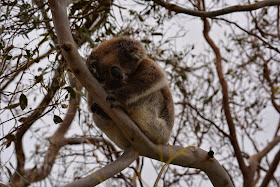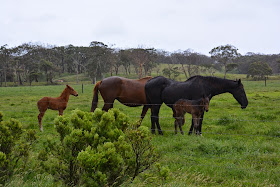We took the car ferry from Sorrento on the eastern side of Port Phillip Bay across to Queenscliff, the town where I spent my early childhood. I still love it so much; it is always a joy to visit. The narrow entrance to the Bay is known as The Rip and is absolutely treacherous. In the photo below, you can see the lifeboat shed on the jetty and, in the distance, Queenscliff's two lighthouses: a white one near the tip of the point and a black (bluestone) one above the lifeboat shed. Our family store was directly behind the impressive building with the tower to the far right (the Ozone Hotel).
The Great Ocean Road itself starts a little further along the coast at the surfing mecca of Torquay. The road is Australian National Heritage listed and was built by returned soldiers between 1919 and 1932. It stretches for 151 miles/243 km of spectacular coastal scenery.
We pulled in for a leg stretch and wander at Cumberland River Holiday Park. If we hadn't been short of time, this would have made a wonderful stop-over.
Instead, we continued onwards to Apollo Bay for the night.
 |
| Our overnight destination, Apollo Bay, where we stayed in such a beautiful B&B it warrants its own blog post! |
 |
| Some of the locals in Apollo Bay |
The next morning we continued our drive east to Cape Otway National Park, where Jayne was able to see some true blue Aussies up close - koalas.
And being the tail end of Spring, there were beautiful babies to see in the surrounding countryside.
The stretch of coastline that is home to the famous Twelve Apostles is known as the Shipwreck Coast. Hundreds of ships fell victim to the treacherous conditions during the 1800s. One of the most famous was the Loch Aird, which gives its name to the gorge where it came to grief.
Of 54 passengers and crew, just two teenagers survived, a young Irish girl who was emigrating with her family and the ship's apprentice, fifteen-year old Tom Pearce, who climbed out of the gorge to raise the alarm.
After continuing on to the town of Port Campbell, it was time to head home, and to make sure we caught the last ferry from Queenscliff back to Sorrento, we opted for the inland route, which still offered up lots of glorious rural scenery.
Next post, I'll share my impressions of the wonderful B&B where we stayed at Apollo Bay.

























That part of Australia is on my "to do one day" list - such amazing scenery and the locals aren't bad either. For now, I'll just enjoy the trip through your eyes.
ReplyDeleteIt is a wonderful place to visit, Ros. I've been as far as Lorne a few times, but rarely make it further than that on trips from Melbourne. Next time, I'll allow more than just two days.
DeleteMarisa I always enjoy your treks, and this one was really lovely and well worth the wait for you to post....I hope Jayne enjoyed it as much as I did.
ReplyDeleteI enjoyed the lovely coastal scenery especially the headland with the various sediment rock layers, reminded me of my Geography class in high school.
It is an amazingly rugged coastline down there, Virginia, and changing constantly as the ocean and elements erode the sandstone pillars.
Deleteoh one day I will do the grat ocean road. Beuatiful photos, thanks for sharing them.
ReplyDeleteYou're welcome. I think it is a 'must' for any Aussie's road trip list.
Delete